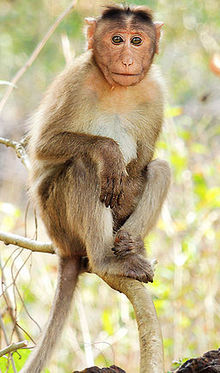| Macaques[1] | |
|---|---|

| |
| Bonnet macaque in Manegaon, Maharashtra, India | |
| Scientific classification | |
| Domain: | Eukaryota |
| Kingdom: | Animalia |
| Phylum: | Chordata |
| Class: | Mammalia |
| Order: | Primates |
| Suborder: | Haplorhini |
| Infraorder: | Simiiformes |
| Family: | Cercopithecidae |
| Tribe: | Papionini |
| Genus: | Macaca Lacépède, 1799 |
| Type species | |
| Simia inuus[1] | |
| Species | |
|
See text | |
The macaques (/məˈkɑːk, -ˈkæk/)[2] constitute a genus (Macaca) of gregarious Old World monkeys of the subfamily Cercopithecinae. The 23 species of macaques inhabit ranges throughout Asia, North Africa, and (in Gibraltar) Europe. Macaques are principally frugivorous (preferring fruit), although their diet also includes seeds, leaves, flowers, and tree bark. Some species such as the long-tailed macaque (M. fascicularis; also called the crab-eating macaque) will supplement their diets with small amounts of meat from shellfish, insects, and small mammals. On average, a southern pig-tailed macaque (M. nemestrina) in Malaysia eats about 70 large rats each year.[3][4] All macaque social groups are arranged around dominant matriarchs.[5]
Macaques are found in a variety of habitats throughout the Asian continent and are highly adaptable. Certain species are synanthropic, having learned to live alongside humans, but they have become problematic in urban areas in Southeast Asia and are not suitable to live with, as they can carry transmittable diseases.
Most macaque species are listed as vulnerable to critically endangered on the International Union of the Conservation of Nature (IUCN) Red List.
- ^ a b Groves, C. P. (2005). Wilson, D. E.; Reeder, D. M. (eds.). Mammal Species of the World: A Taxonomic and Geographic Reference (3rd ed.). Baltimore: Johns Hopkins University Press. pp. 161–165. ISBN 0-801-88221-4. OCLC 62265494.
- ^ "macaque". Lexico UK English Dictionary. Oxford University Press. Archived from the original on October 24, 2021.
- ^ Keach, Sean (October 22, 2019). "Rat-eating monkeys in Malaysia stun scientists". The Sun.
- ^ Guy, Jack (October 22, 2019). "Rat-eating macaques could boost palm oil sustainability in Malaysia". CNN.
- ^ Fleagle, John G. (8 March 2013). Primate Adaptation and Evolution. Academic. p. 123. ISBN 978-0-12-378633-3.